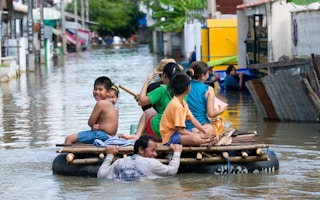Over the last 70 years, floods have increased more than any other type of natural disaster, and evidence shows that Asia’s developing countries are particularly vulnerable – the most destructive floods in the past years occurred in the region.
It is said that Asia has registered about half of the total worldwide economic losses resulting from flooding, and this is in addition to damages to the physical environment and human population.
The 2011 flood that hit Bangkok was Thailand’s worst in half a century, affecting more than a third of Thai provinces, killing hundreds of people, destroying millions of acres of crops, and forcing thousands of factories to close. Bangkok has not seen this great volume of floodwaters since the great flood of 1940.
Who can forget Ondoy (international name Ketsana), the tropical storm that hit Metro Manila in 2009, and Typhoon Yolanda (Haiyan), which devastated many parts of the Philippines in 2013, killing thousands. The latter left many families homeless and until now, many of them are still living in evacuation sites.
Ironically, this increasing trend is happening at a time when our technological capabilities for dealing with floods have advanced rapidly over the same period, and despite approaches to flooding having incorporated so-called “structural” and “non-structural” interventions. It’s easy to blame climate change, but climate change is here to stay – so what do we do?
Floods are not ‘natural’ disasters
There is growing evidence that most flood-related disasters, although commonly referred to as natural disasters, are not in fact the results of nature-related processes alone. They are to an ever-increasing extent directly attributable to various social, economic, political, and even cultural issues. There are a great deal of natural and social interactions that shape the vulnerability to floods.
In most urban cases, severe flooding can be attributed to engineering and hydraulic factors, including a general loss of run-off capacity to attenuate flows to waterways and an almost complete loss of open natural and/or manmade “corridors” for rivers and waterways to spill over and temporarily flood. The “over-engineering” of rivers to create straight, non-meandering waterflows has created fast-flowing channels with limited brake on flow. Lapsed maintenance, including dredging, has also impacted adversely. A general lack of storm water and drainage systems exacerbates all of this.
“
Asian cities’ vulnerability to floods can also be primarily attributed to poor and fragmented urban planning and management.
Crucially, non-technical factors have just as much impact. Unstoppable expansion of slums on riverbanks prevents engineering interventions and maintenance. These informal settlements lead to clogging of waterways through randomly disposed garbage, blocking drainage channels and narrow watercourses. And of course there is a general change in rainfall patterns due to climate change, including timing, frequency, intensity and duration.
Asian cities’ vulnerability to floods can also be primarily attributed to poor and fragmented urban planning and management. A lack of coherent and managed planning allowed the phenomenal movement of population from rural areas to cities. Better planning and management would have partially halted rapid buildup of slums along coasts and riverbanks.
It is obvious that the solutions are far beyond what structural interventions can offer. Improving urban planning and management requires breaking silos, unlearning fragmented thinking, and veering away from short-term measures.
This is why reliance on engineering solutions and technologies is not enough. We need to shift to a more holistic approach that takes into account ecological and social considerations as well.
Holistic planning for flood resilience, management
Green cities development is about creating cities that are sustainable, efficient, adaptive, and resilient. It offers a holistic perspective that recognizes the connections among different sectors and supports strategies that can fulfill multiple functions and create multiple benefits.
In moving towards green cities development, flood management should be based on holistic planning. Flood resilience measures should be designed within the context of the broader ecosystem. Flood management should adopt multifunctional measures that are not only technologically and economically efficient, but also ecologically sustainable and socially fair. The overall idea is that each individual measure is designed to work in conjunction with other measures, to provide an interconnected set of measures which can enable better resilience and adaptive capacity than any other measure when designed alone.
This requires a major change in mindset of decision-makers and planners in government. So where do we start? How do we begin the change in mindset?
The “Unflooding Asia: The Green Cities Way” publication presents examples of where these approaches have worked, and what the benefits have been. In the PRC, Beijing has started moving toward adopting multi-functional solutions using the low-impact development approach. The city currently features the largest application of pervious pavements, favored not only for their visual effect on the landscape but also for their capacity to significantly reduce runoff and pollution. In the Republic of Korea, the Netherlands, Germany and many other countries in Europe, examples of multi-functional measures to manage floods abound.
We are not short of good examples. What we need is a strong resolve to shift to these new measures because business as usual no longer works.
Amy Leung is Director of Urban Development and Water Division in Southeast Asia at ADB. This post was originally published on the Asian Development Bank blog.


















